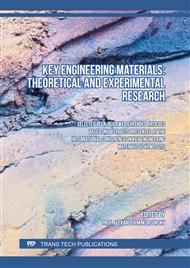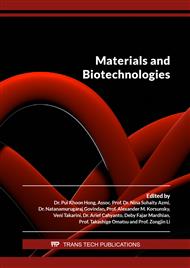[1]
M. Cai, H. Takagi, A. N. Nakagaito, Y. Li and G. I. N. Waterhouse, Effect of alkali treatment on interfacial bonding in abaca fiber-reinforced composites, Compos. - A: Appl. Sci. Manuf. 90 (2016) 589-597.
DOI: 10.1016/j.compositesa.2016.08.025
Google Scholar
[2]
L. Mohammed, M. N. M. Ansari, G. Pua, M. Jawaid and M. S. Islam, A Review on Natural Fiber Reinforced Polymer Composite and Its Applications, Int. J. Polym. Sci. 2015 (2015) 1-15.
DOI: 10.1155/2015/243947
Google Scholar
[3]
P. Gañán, R. Zuluaga, J. M. Velez and I. Mondragon, Biological Natural Retting for Determining the Hierarchical Structuration of Banana Fibers, Macromol. Biosci. 4 (10) (2004) 978-983.
DOI: 10.1002/mabi.200400041
Google Scholar
[4]
Information on http://www.fao.org/faostat.
Google Scholar
[5]
K. J. Vishnu Vardhini and R. Murugan, Effect of Laccase and Xylanase Enzyme Treatment on Chemical and Mechanical Properties of Banana Fiber, J. Nat. Fibers 14 (2) (2017) 217-227.
DOI: 10.1080/15440478.2016.1193086
Google Scholar
[6]
R. Brindha, C. K. Narayana, V. Vijayalakshmi and R. P. Nachane, Effect of different retting processes on yield and quality of banana pseudostem fiber, J. Nat. Fibers 16 (1) (2019) 58-67.
DOI: 10.1080/15440478.2017.1401505
Google Scholar
[7]
L. D. Soraisham, N. Gogoi, L. Mishra and G. Basu, Extraction and Evaluation of Properties of Indian Banana Fibre (Musa Domestica Var. Balbisiana, BB Group) and Its Processing with Ramie, J. Nat. Fibers (2021) 1-12.
DOI: 10.1080/15440478.2021.1897728
Google Scholar
[8]
K. Vishnu Vardhini, R. Murugan and R. Surjit, Effect of alkali and enzymatic treatments of banana fibre on properties of banana/polypropylene composites, J. Ind. Text. 47 (7) (2018) 1849-1864.
DOI: 10.1177/1528083717714479
Google Scholar
[9]
G. M. Arifuzzaman Khan, M. S. Alam Shams, M. R. Kabir, M. A. Gafur, M. Terano and M. S. Alam, Influence of chemical treatment on the properties of banana stem fiber and banana stem fiber/coir hybrid fiber reinforced maleic anhydride grafted polypropylene/low-density polyethylene composites, J. Appl. Polym. Sci. 128 (2) (2013) 1020-1029.
DOI: 10.1002/app.38197
Google Scholar
[10]
B. Deepa, E. Abraham, B. M. Cherian, A. Bismarck, J. J. Blaker, L. A. Pothan, A. L. Leao, S. F. De Souza and M. Kottaisamy, Structure, morphology and thermal characteristics of banana nano fibers obtained by steam explosion, Bioresour. Technol. 102 (2) (2011) 1988-1997.
DOI: 10.1016/j.biortech.2010.09.030
Google Scholar
[11]
Z. Sheng, J. Gao, Z. Jin, H. Dai, L. Zheng and B. Wang, Effect of steam explosion on degumming efficiency and physicochemical characteristics of banana fiber, J. Appl. Polym. Sci. 131 (16) (2014).
DOI: 10.1002/app.40598
Google Scholar
[12]
H. Mardin, I. G. Wardana, Pratikto, W. Suprapto and K. Kamil, Effect of Sugar Palm Fiber Surface on Interfacial Bonding with Natural Sago Matrix, Adv. Mater. Sci. Eng. 2016 (2016) 1-5.
DOI: 10.1155/2016/9240416
Google Scholar
[13]
B. Rashid, Z. Leman, M. Jawaid , M. J. Ghazali and M. R. Ishak, Influence of Treatments on the Mechanical and Thermal Properties of Sugar Palm Fibre Reinforced Phenolic Composites, BioResources 12 (2017) 1447-62.
DOI: 10.15376/biores.12.1.1447-1462
Google Scholar
[14]
B. Rashid, Z. Leman, M. Jawaid, M. J. Ghazali and M. R. Ishak, Physicochemical and thermal properties of lignocellulosic fiber from sugar palm fibers: effect of treatment, Cellulose 23 (5) (2016) 2905-2916.
DOI: 10.1007/s10570-016-1005-z
Google Scholar
[15]
S. Juradin, I. Boko, I. Netinger Grubeša, D. Jozić and S. Mrakovčić, Influence of different treatment and amount of Spanish broom and hemp fibres on the mechanical properties of reinforced cement mortars, Constr. Build. Mater. 273 (2021) 121702.
DOI: 10.1016/j.conbuildmat.2020.121702
Google Scholar
[16]
R. Sana, K. Foued, B. M. Yosser, J. Mounir, M. Slah and D. Bernard, Flexural properties of typha natural fiber-reinforced polyester composites, Fibers Polym. 16 (11) (2015) 2451-2457.
DOI: 10.1007/s12221-015-5306-x
Google Scholar
[17]
L. Jiang, P. Du and H. Wang, Seawater modification of lignocellulosic fibers: comparison of rice husk and rice straw fibers, Mater. Res. Express 8 (3) (2021) 035102.
DOI: 10.1088/2053-1591/abe8c4
Google Scholar
[18]
L. Jiang, H. Wang, Y. Kong and P. Du, Physicochemical and thermal properties of lignocellulosic fibers from wheat straw: Effect of seawater modification, Mater. Res. Express 8 (2021) 055101.
DOI: 10.1088/2053-1591/abf9cb
Google Scholar
[19]
A. El Oudiani, Y. Chaabouni, S. Msahli and F. Sakli, Physico-chemical characterisation and tensile mechanical properties of Agave americanaL. fibres, J. Text. Inst. 100 (5) (2009) 430-439.
DOI: 10.1080/00405000701863350
Google Scholar
[20]
F. Gapsari, A. Purnowidodo, S. Hidayatullah and S. Suteja, Characterization of Timoho Fiber as a reinforcement in green composite, J. Mater. Res. Technol. 13 (2021) 1305-1315.
DOI: 10.1016/j.jmrt.2021.05.049
Google Scholar
[21]
L. A. Elseify, M. Midani, A. H. Hassanin, T. Hamouda and R. Khiari, Long textile fibres from the midrib of date palm: Physiochemical, morphological, and mechanical properties, Ind. Crops Prod. 151 (2020) 112466.
DOI: 10.1016/j.indcrop.2020.112466
Google Scholar
[22]
M. Bar, H. Belay, A. Ramasamy, A. Das and P. Ouagne, Refining of Banana Fiber for Load Bearing Application through Emulsion Treatment and Its Comparison with Other Traditional Methods, J. Nat. Fibers (2021) 1-18.
DOI: 10.1080/15440478.2021.1902901
Google Scholar



